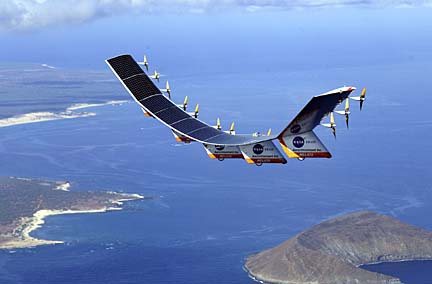


NASA aims high BARKING SANDS, Kauai >> NASA hopes to achieve a world altitude record by a non-rocket powered aircraft today when the Helios Prototype flying wing attempts to fly three times higher than any commercial jet.
with Helios launch
The solar-powered craft hopes
to break high-altitude recordsBy Jaymes Song
Associated PressThe remotely controlled, solar-electric powered aircraft is scheduled to take off shortly after 8 this morning from the Navy's Pacific Missile Range Facility on Kauai.
NASA officials said with ideal weather conditions, the Helios is capable of reaching an altitude of 100,000 feet -- more than midway through the stratosphere to a height of 19 miles.
"It's not a slam dunk," said John Del Frate, NASA project manager. "The flight has to go perfectly (to reach 100,000 feet)."
The Helios reached an altitude of 76,271 feet on its test flight last month off Kauai. The record is 85,068 feet set by an SR-71 aircraft in 1966.
"People are just chomping at the bit, they're more than ready," said NASA program manager John Hicks following yesterday's final staff briefing. "This has been a long deployment, a very challenging operation and they're eager to see this fly."
A team of 30 engineers and technicians has been working since April preparing for today's launch.
NASA developed the Helios with AeroVironment Inc., of Monrovia, Calif., in a bid to build a remotely piloted aircraft that could replace space satellites for some applications.
The main objective of the flight is to expand Helios' performance to a maximum capability to see what it can do, Hicks said. Once that is determined, the aircraft can be sent on a planned 96-hour mission at a 60,000-foot altitude in 2003, he said.
The aircraft is envisioned as a surrogate satellite, or low-cost telecommunications relay platform capable of providing high-speed Internet access. It also is the best platform for measuring the earth's atmosphere at the 60,000- to 100,000-foot level, and can be used for such purposes as accurately tracking hurricanes, NASA said.
"What we're looking for is Earth observation platforms that can fly above the weather and all flying traffic for long sustained periods," Hicks said.
Since the atmosphere at 100,000 feet is similar to that expected in the Martian atmosphere, the data collected from the Helios at high altitudes will also help engineers plan for future Mars aircraft designs, NASA said.
The $15 million aircraft is controlled from the ground on desktop computers by AeroVironment pilots Greg Kendall and Wyatt Sadler. Its 14 specially designed propellers are driven by small 2-horsepower motors powered by 65,000 solar cells covering the wing.
The Helios, made of carbon fiber, graphite epoxy, Kevlar, styrofoam and a plastic skin, is extremely flexible, lightweight and durable.
NASA officials said Kauai was selected for its large test range, isolation and ideal sun angles.
The Helios needs relatively no clouds and no wind or rain for a successful liftoff and landing.
It will also take a little luck, Hicks said.
"It's so one of a kind, it's so high-tech that everything we that we do is kind of a first time effort," he said. "Nobody in the world has this kind of an aircraft. Nobody in the world has ever flown this operation."